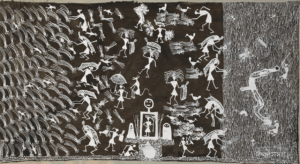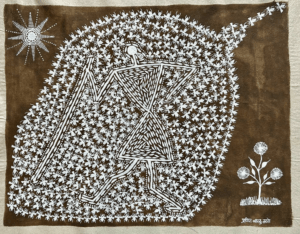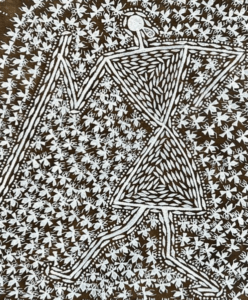Developed by Mamta Tripathi and Patrica Sabarwal (YHS Fulbright-Hays 2022)
वारली जनजाति: कंसारी माता एक लोक कथा
This lesson plan is a part of the Warli Tribe Unit in the following sequence:
- Geography and Environment
- A Warli Folk Tale: Kansari Devi
- Sustainable Lifestyle of Warli Community
Proficiency Level: Intermediate Low-Intermediate Mid
Students: HLL and FLL; Age: High school and post-secondary
Time: 4X60 min.
Essential Questions: What is the role of folktales in shaping the moral values of an individual?
Learning Objectives: By the end of this lesson students will be able to-
- identify and state the main theme of a simple story
- identify and sequence the beginning, middle and end of a short story
- discuss and come up with a moral of the story
- exchange information about sequence of the story by asking and answering questions
- create an alternate ending of the story
- present an audio-visual story that inculcates humanitarian values, using a series of connected sentences
Language Structures:
- Present Habitual tense (verb stem +ता/ ते/ ती and appropriate form of होना)- मानते हैं, जाती हैं, करती हैं, माँगती हैं, देते हैं
- कर construction (verb stem +कर)- पहनकर, जाकर, मारकर, होकर
- Conjunctions– लेकिन, बल्कि, फिर भी, और, तब
Vocabulary List:
| समुदाय (m) | community | निराश | disappointed |
| मानना | to believe | बढ़ना | to proceed |
| परीक्षा (f) | exam | आखिर में | in the end |
| देवी (f) | goddess | उदार | generous |
| मैला | dirty | दयालु | kind |
| बूढ़ी | old woman | संस्कृति (f) | culture |
| गरीब | poor | भावना (f) | feelings |
| वेश धारण करना | to take form | अतिथि देवो भवः | guest is God |
| गंदगी (f) | dirtiness | के बावजूद | in spite of |
| मक्खियाँ (f) | flies | भर पेट | tummy full |
| माँगना | to beg, to ask | असली | real |
| लेकिन | but, however | रूप (m) | form |
| बल्कि | but, rather | आशीर्वाद देना | to bless |
| पत्थर (m) | stone | अनाज (m) | grains |
| मारना | to hit | कमी | dearth |
| भाग जाना | to run away |
Performance Assessment Task: The International Kolkata Book Fair is a winter fair in Kolkata. It is a unique book fair in the sense of not being a trade fair meant for whole-sale distributors, rather it is a book fair primarily for the general public, including children from local schools. Hindi schools have been invited for children’s storytelling competition – हिन्दी कथावाचन प्रतियोगिता. Your class has decided to present a moral value-building story that you will be writing.
- Role: Author and storyteller of young audience stories
- Audience: Grade school children
- Format: Storytelling – Book Creator/Picture book with Captions/ Google slides
- Topic: Moral value-building Folktale
Learning Episodes:
1. Warm up activity: ask if students know any folk tales, what was the moral/learning, ask about characters, setting, problem, solution, etc. in the story. Ask if they know any stories where a character disguises, what was the purpose. What was the outcome?
2. Grammar Mini lesson: Conjunctions in Hindi
3. Think-Pair-Share activity: Students will closely observe the realia or its picture (image below) and discuss what they see. They will predict the theme and setting using शायद & मुझे लगता है कि. They will closely observe and describe the image of the main character of the story (उम्र, पहनावा, दिखावट) using conjunctions. For example:
-
- शायद कहानी में एक लड़की है।
- कहानी एक बूढ़ी औरत के बारे में है।
- मुझे लगता है जंगल में है और हाइकिंग कर रही है।
- मधुमक्खियों से भाग रही है।
4. Mini lesson: Students learn the basics of कर construction and do the two activities on the provided link. Then they create 5 sentences using this construction in the context of their daily life, a recipe, another popular story, or a context of their choice. For example:
-
- मैं सुबह उठकर योग करता हूँ।
- मैं खाना बनाकर काम पर जाता हूँ।
- गीता स्कूल से आकर टीवी देखकर होमवर्क करती है।
- हाथ धोकर खाना खाओ।
5. Pair work: Students will watch a short video clip (6:59-8:28 mins) and discuss with their partner to
-
- make a list of the conjunctions and कर constructions they hear in the story
- map the story on a graphic organizer
- discuss and come up with a moral for the story
- create an alternate ending for the story OR narrate the story as the main character (Kansaarii maataa)
6. Jigsaw activity: Different groups will read different parts of the story (text below) and then come together to sequence it in a logical way by asking questions and answering them by using कर constructions. They will also create 2 questions for the author and/or the main character.
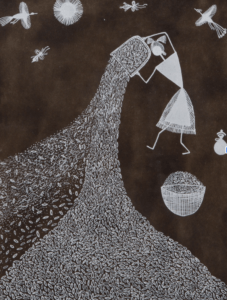
7. Comparison activity: Students compare the story that they have heard in the video with the story that they have read and point out 3 differences and 3 similarities, using conjunctions.
8. Literacy activity: Every student will get a script of the key happenings that take place in the story on several strips of paper. They will read independently and create a sequence of the story. They will take turns reading the story to their partner to check the sequence.
9. Performance task has been outlined above. Adaptable rubric for evaluation is provided with the task. Students will include the following grammar structures in their stories:
-
- 6+ conjunctions
- 10+ habitual construction
- 5+ कर construction
- 6+ adjectives to describe setting and characters
10. Gallery-walk for peer evaluation of the products-
-
-
- students listen to/view each product to vote for the best story, best narration style, best visuals, best overall presentation and
- give feedback in the form of – ‘what I would do differently’ to each presenter.
- give reasons for voting the ‘best’ title in each category.
-
Story Text (Quasi-authentic)
कंसरी माता की कहानी
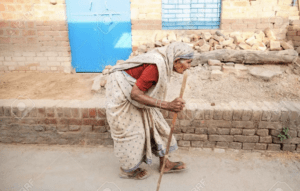
कंसरी माता को वारली समुदाय में चावल की देवी मानते हैं।
एक समय की बात है लोगों की परीक्षा लेने के लिए कंसरी देवी एक गाँव में जाती हैं। वे मैले कपड़े पहनकर एक बूढ़ी गरीब औरत का वेश धारण करती हैं। गंदगी के कारण उनके चारों ओर मक्खियाँ भिनभिना रही थीं।
इस हालत में वे घर घर जाकर खाने के लिए कुछ माँगती हैं लेकिन कोई भी उन्हें कुछ नहीं देता। बल्कि लोग उनपर पत्थर मारकर कहते हैं, “तुम बहुत गंदी हो, यहाँ से भाग जाओ”। वे निराश होकर वहाँ से आगे बढ़ती हैं और दूसरे घर में जाकर पीने के लिए पानी माँगती हैं, लेकिन कोई उन्हें पानी भी नहीं देता। फिर भी वे हार नहीं मानतीं।
आखिर में वे एक ऐसे घर में पहुँचती हैं जहाँ उदार और दयालु लोग रहते थे। वे भारतीय संस्कृति की भावना “अतिथि देवोभवः” को मानते थे। मैली और गंदी होने के बावजूद भी वे लोग उस बुढ़िया को अपने घर के अंदर ले जाते हैं और उसे भर पेट खाना देते हैं।
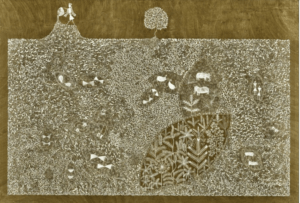
तब कंसारी माता अपने असली रूप में आ जाती हैं और उनको आशीर्वाद देती हैं कि चाहे वे काम करें या न करें, उनके घर में कभी भी अनाज की कमी नहीं होगी।
Sample Story and Rubrics
